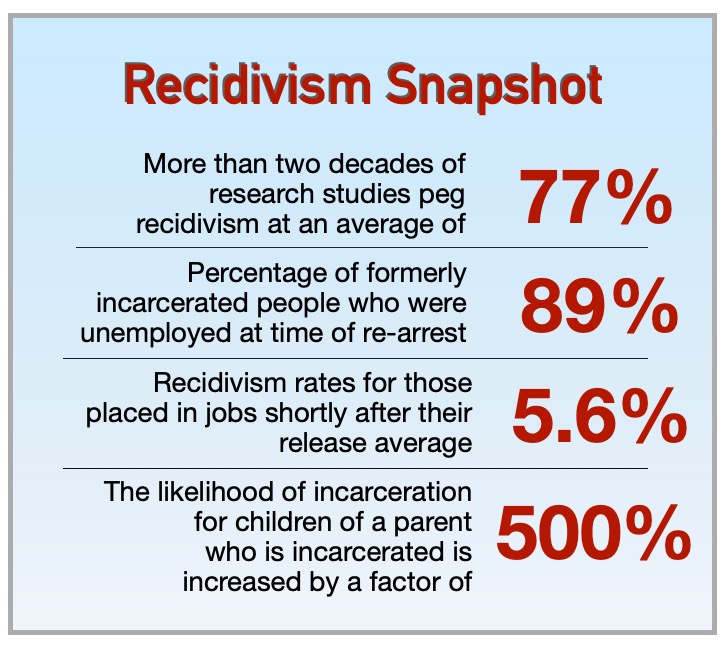Our mission is to reduce recidivism and rebuild lives through the dignity of work.


For at least 20 years, recidivism rates across the nation have invariably hovered around an average of 77%. These numbers come from the most highly accurate sources: The Bureau of Justice Statistics (BJS), the Congressional Research Service (CRS), Brookings.edu, and the United States Sentencing Commission (USSC). All use the only accurate method of tracking those who are released and return to incarceration, which is reading and recording thousands of inmates' individual criminal records over the years.
It is confusing that Indiana statistics measure recidivism percentages by county that run in the 20-40% range. Here's why: Using Indiana Department of Corrections (IDOC) data, they are recording recidivism that occurs only when a person is released from an Indiana prison and recidivates into an Indiana prison. IDOC does not have access to individual data on those who are re-incarcerated from or to other states, or even in or out of Indiana county jails. The numbers are not inaccurate, they are limited by the data IDOC has at its disposal, giving quite a different outcome from those found by research-based organizations.
The Bureau of Justice Statistics, for example, has been monitoring recidivism for 50 years and examines recidivism patterns during 9-year follow-up periods. Repeated studies, one 16 years ago and another 20 years ago reach the same level of recidivism as the most recent study that finds those percentages in the upper 70s.
It matters because Indiana is spending around $1 billion on incarceration and criminal correction annually. At a time when violence is rampant and we spend a growing amount on incarceration and criminal corrections, it is imperative to have accurate numbers with which to form a real response to the recidivism problem.
But, one of the most haunting statistics reveals that the children of an incarcerated parent are five times more likely to be incarcerated. If the human aspect is removed out of this frightening statistic, the financial burden of incarceration will continue to grow. Percentages of recidivism like 77% may remain static, but 77% of 4,000 or 20,000, is a huge difference in both human and monetary capital. It is time for a common sense response to this issue.

Two important studies verify the importance of a job to keep people from crime and recidivism. A research summary by Zippia in 2022 found that around 89% of formerly incarcerated people who are re-arrested are unemployed at the time of their arrest. Another study by Manhattan Institute, again following actual reentrants, found that getting a job soon after release drove recidivism down 90%. The study says, "Statewide rates of recidivism range from about 31 to 70 percent, while the rates for those placed in jobs shortly after their release ranged from 3.3 to eight percent." 2nd Chance Indiana focuses on working with employers that pay a living wage. While the average working reentrant reportedly makes $295 per week, the average pay scale for 2ndChanceIN.com reentrant jobs is $700 per week--starting salary.
For your own full size copy of the infographic on the left, Click Here!
1. Reducing recidivism is critical for community safety and reduction of violence.
2. Providing rehabilitation and skill development for those before and after reentry is crucial to success.
3. Successful reentry strengthens households and the overall economy.
The dignity of work is a powerful motivator. It allows reentrants to provide better health care for children, better food options, and improved educational opportunities as it reduces housing instability, all of which contribute directly to the formation of a more equitable and a safer society.
NOTE: BJS findings are based on data on the number and types of crimes prisoners commit after release, whether the arrest was within or outside the state of release. Findings are based on data from BJS's Recidivism Study of State Prisoners Released in 2005 data collection, which tracked a sample of former prisoners from 30 states for 9 years following release in 2005. Source data are from prisoner records reported by state departments of corrections to BJS's National Corrections Reporting Program and national criminal history records from the FBI's Interstate Identification Index and state criminal history repositories via the International Justice and Public Safety Network. BJS findings report that 68% of released prisoners were arrested within 3 years, 79% within 6 years, and 83% within 9 years--an average of 77%.